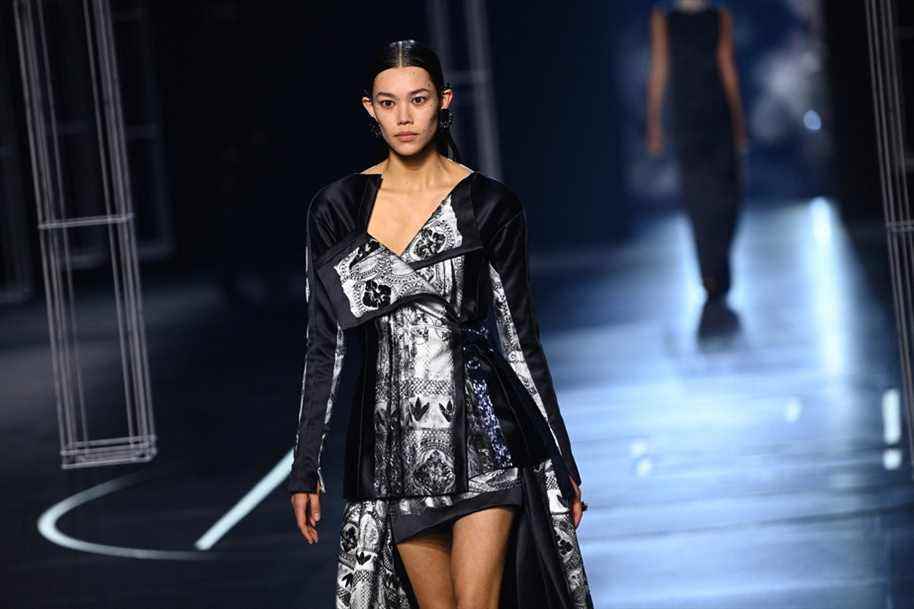(Paris) Fendi staged powerful women on Thursday, embodied by an “army of empresses”, on the last day of haute couture in Paris under the sign of multiculturalism.
Posted at 2:55 p.m.
In a futuristic staging, the British Kim Jones, director of the women’s collections of the Roman house Fendi and also stylist of Dior Homme, celebrated the aesthetic “ecclesiastical” and “marble sculptures” with rigid silhouettes.
His “empresses” move forward as if suspended on platform shoes that stop in the middle of the foot, without a heel, and make several of them stumble in a universe that is a bit anxiety-provoking.
The statues outside the Palazzo della Civiltà Italiana, Fendi’s headquarters in Rome, are hand-painted on mink and velvet.
The cuts are imposing, the colors saturated: black, midnight blue, red, mauve.
Warrior armor and royal trains: “my raison d’être at Fendi is to celebrate the power of women”, declares Kim Jones in the statement of intent for the show.
Imane Ayissi’s slogans

PHOTO GEOFFROY VAN DER HASSELT, AGENCE FRANCE-PRESSE
Cameroonian Imane Ayissi plays with slogans. A message is transmitted on a white dress where one can read “No Fashion on a dead planet”.
Cameroonian Imane Ayissi plays with slogans, borrowing from West African textile cultures.
The word “foufoullou” in the Ewondo language of Cameroon which means “mixed” and “together” is written on many of these dresses.
Another message is transmitted with the first look, a white dress where we can read “No Fashion on a dead planet”.
In dresses that mix shades of green and pink, he makes sequins flirt with kente from Ghana or lace from Calais with adire dyes from Nigeria.
Former dancer of the National Ballet of Cameroon and the company of Patrick Dupont, model for the biggest luxury brands, Imane Ayissi made history in 2020 by becoming the first designer from sub-Saharan Africa to appear on the official calendar of the high fashion.
An admirer of Balenciaga, influenced by his years in the ballet corps, but just as passionate about the African textile heritage, he cultivates his cultural mix.
After the parade Thursday, he was awarded the medal of Knight of the Order of Arts and Letters.
Manga and No Theater by Yuima Nakazato

PHOTO GEOFFROY VAN DER HASSELT, AGENCE FRANCE-PRESSE
The Japanese Yuima Nakazato placed his parade in a world of No theater, populated by dancers and models with colored hair.
As for the Japanese Yuima Nakazato, he placed his parade on Thursday in a world of No theater, populated by dancers and models with colored hair.
The contrast is striking between the dancers with bleached faces and in evanescent dresses who perform pantomimes, like ghosts, and the presence of women and men parading with their big Gothic-inspired boots, shoes rarely seen in haute couture.
With their asymmetrical cuts and red and purple hair, they seem straight out of manga.
The bright colors and psychedelic patterns on the kimonos and evening dresses stand out in the sober interior of the Oratoire du Louvre, a Protestant temple, where the parade takes place in billows of smoke.
A graduate of the Royal Academy of Fine Arts in Antwerp, Yuima Nakazato, 37, who had previously created costumes for singers, remains faithful to his theatrical and experimental aesthetic questioning the relationship between the body and society.
The Russian house Yanina Couture, which paraded for the first time as part of the official calendar, closed the week of haute couture on Thursday evening with a collection in spring colors with airy or frilly rainbow dresses.
Imagined as a bridge between the Seine and the Volga, the house founded by Yulia Yanina in 1993 combines French know-how and the heritage of Russian decorative arts.
